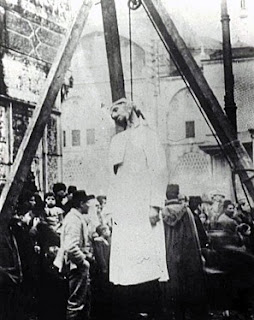Геноци́д армя́н, организованный и осуществлённый в 1915 году (по мнению некоторых источников, продлившийся до 1923 года) на территориях, контролируемых властями Османской империи. Геноцид осуществлялся путём физического уничтожения и депортации, включая перемещение гражданского населения в условиях, приводящих к неминуемой смерти.
Геноцид армян проводился в несколько стадий: разоружение армянских солдат, избирательная депортация армян из пограничных районов, принятие закона о высылке, массовая депортация и убийства армян. Некоторые историки включают в него убийства 1890-х годов, резню в Смирне и действия турецких войск в Закавказье в 1918 году (см. Османская империя и Республика Армения в 1918—1923 годах).
Основными организаторами геноцида армян считаются лидеры младотурок Талаат, Джемаль и Энвер, а также руководитель «Особой организации» Бехаэддин Шакир. Одновременно с этим в Османской империи имели место геноцид ассирийцев и геноцид понтийских греков. Бо́льшая часть армянской диаспоры возникла из бежавших из Османской империи армян.
Термин «геноцид» в своё время был предложен для обозначения массового уничтожения армян в Османской империи и евреев на территориях, оккупированных нацистской Германией. Наряду с Холокостом, геноцид армян является одним из двух наиболее исследованных актов геноцида в истории. В совместной Декларации от 24 мая 1915 года стран-союзниц (Великобритания, Франция иРоссия) массовые убийства армян впервые в истории были признаны преступлением против человечности.
The Armenian Genocide was the systematic killing of the Armenian population of the Ottoman Empire during and just after World War I.[5] It was implemented through wholesale massacres and deportations, with the deportations consisting of forced marches under conditions designed to lead to the death of the deportees. The total number of resulting Armenian deaths is generally held to have been between 1 million and 1.5 million. Other ethnic groups were similarly attacked by the Ottoman Empire during this period, includingAssyrians and Greeks, and some scholars consider those events to be part of the same policy of extermination.
It is widely acknowledged to have been one of the first modern genocides, as scholars point to the organized manner in which the killings were carried out to eliminate the Armenians, and it is the second most-studied case of genocide after the Holocaust. The word genocide was coined in order to describe these events.
The starting date of the genocide is conventionally held to be April 24, 1915, the day when Ottoman authorities arrested some 250 Armenian intellectuals and community leaders in Constantinople.[22][23] Thereafter, the Ottoman military uprooted Armenians from their homes and forced them to march for hundreds of miles, depriving them of food and water, to the desert of what is now Syria. Massacres were indiscriminate of age or gender, with rape and other sexual abuse commonplace. The majority of Armenian diaspora communities were founded as a result of the Armenian genocide.
The Republic of Turkey, the successor state of the Ottoman Empire, denies the word genocide is an accurate description of the events.In recent years, it has faced repeated calls to accept the events as genocide. To date, twenty countries have officially recognized the events of the period as genocide, and most genocide scholars and historians accept this view.


















































































No comments:
Post a Comment